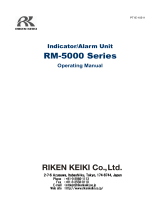
2 Important Notices on Safety 2-3. Precautions
SC-8000 - 6 -
CAUTION
Do not use the gas monitor where it is exposed to oil, chemicals, etc. Do not submerge the gas
monitor under water on purpose.
• Do not use in a place where the gas monitor is exposed to liquids such as oil and chemicals.
• The gas monitor, being compliant to IP67, is not water-pressure-resistant. Do not use the gas
monitor where a high water pressure is applied to it (under a faucet, shower, etc.) or submerge it
under water for a long time. The gas monitor is water-proof only in fresh water and running water,
and not in hot water, salt water, detergent, chemicals, human sweat, etc.
• The gas inlet and outlet are not water-proof. Be careful not to let water such as rainwater get into
these parts. Because this may cause trouble and gas cannot be detected.
• Do not place the gas monitor where water or dirt gets accumulated. The gas monitor placed at such a
location may malfunction due to water or dirt that gets into the buzzer opening, gas inlet, etc.
• Note that drawing in dirty water, dust, metallic powder, etc. will significantly deteriorate the sensor
sensitivities. Be careful when the gas monitor is used in an environment where these elements exist.
Do not use the gas monitor in a place where the temperature drops below -10ºC or rises over 40ºC.
• The operating temperature of the gas monitor is -10 to 40ºC. Do not use the gas monitor at higher
temperatures, humidities, and pressures or at lower temperatures than the operating range.
• Avoid long-term use of the gas monitor in a place where it is exposed to direct sunlight.
• Do not store the gas monitor in a sun-heated car.
Observe the operating restrictions to prevent condensation inside the gas monitor or sampling probe.
Condensation formed inside the gas monitor or sampling probe causes clogging or gas adsorption,
which may disturb accurate gas detection. Thus, condensation must be avoided. In addition to the
operating environment, carefully monitor the temperature/humidity of the sampling point to prevent
condensation inside the gas monitor or sampling probe. Please observe the operating restrictions.
Do not use a transceiver near the gas monitor.
• Radio wave from a transceiver near the gas monitor may disturb readings. If a transceiver is
used, it must be used in a place where it disturbs nothing.
• Do not use the gas monitor near a device that emits strong electromagnetic waves
(high-frequency or high-voltage devices).
Verify that the pump driving indicator is rotating before using the gas monitor.
If the pump driving indicator is not rotating, gas detection cannot be performed properly. Check
whether the flow rate is lost.
Do not forget to perform a regular maintenance.
Since this is a safety unit, a regular maintenance must be performed to ensure safety. Continuing to
use the gas monitor without performing a maintenance will compromise the sensitivity of the sensor,
thus resulting in inaccurate gas detection.
Direct the LCD display upward.
Use the gas monitor with the LCD display facing upward. The gas monitor, when used with the LCD
display in a tilted or flat status, may not display correct values. Likewise, store the gas monitor with
the LCD display facing upward.
Others
• Pressing buttons unnecessarily may change the settings, preventing alarms from activating
correctly. Operate the gas monitor using only the procedures described in this operating manual.
• Do not drop or give shock to the gas monitor. The water-proof and explosion-proof properties
and accuracy may be deteriorated.
• Do not use the gas monitor while charging it.
2-3. Precautions
























